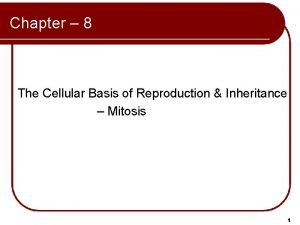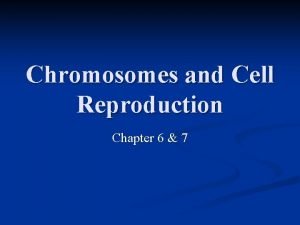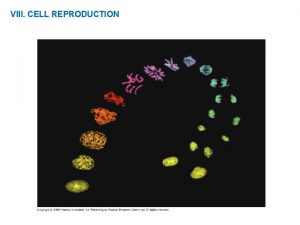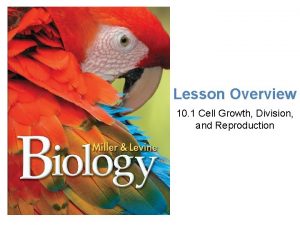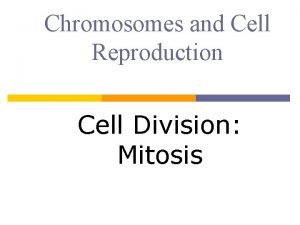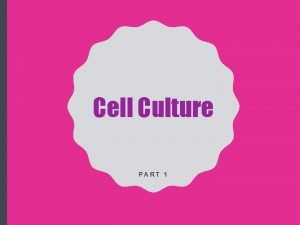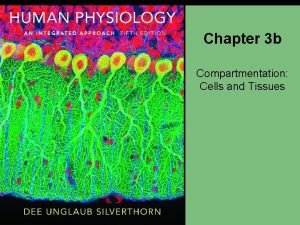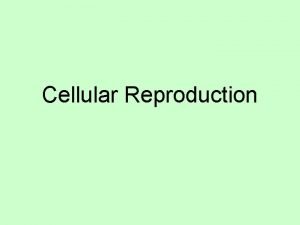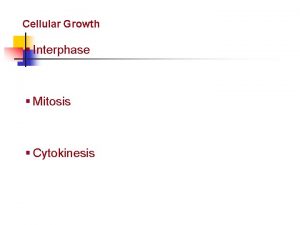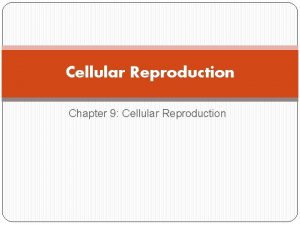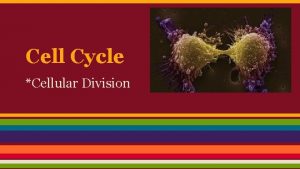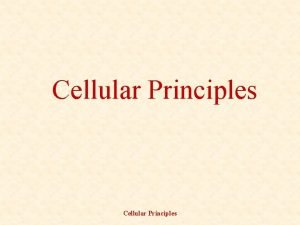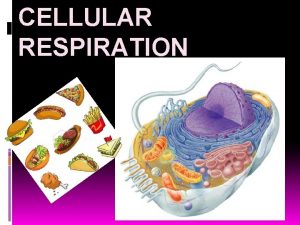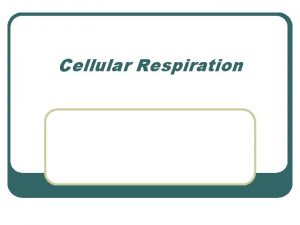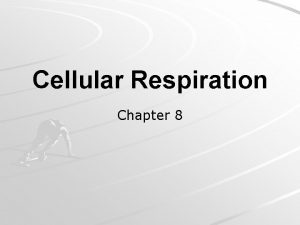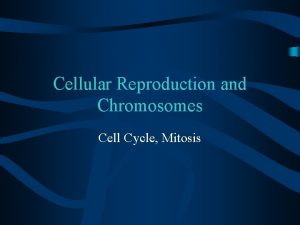Cellular Reproduction Cell Reproduction What is cell reproduction

















































- Slides: 49

Cellular Reproduction




Cell Reproduction • What is cell reproduction? • How many cells make up your body? • How does the chromosome transmit information from one generation to another?

• DNA is a molecule that contains the genetic code of an organism.

• A GENE is a segment of DNA that transmits information from parent to offspring. A single molecule of DNA has thousands of genes lines up end to end. • Like the strands of a sock…DNA coils tightly before cell division. If it were straight the DNA would be approximately 5 cm long. (2 inches)

Gene • When the cell is going to divide the DNA coils up into a dense chromosome structure.

Chromosome • Cellular structure on which genes are located. • Pg. 212

• Chromosomes are 40% DNA and 60% protein that supports the DNA (histones). • Scientists have mapped the 100, 000 genes that make up the chromosomes of humans.

A set of chromosomes from a female

Chromosome structure

• Chromatids are the two copies of each chromosome. • Centromeres are protein disks that attach the two chromatids.


• A karyotype is the collection of chromosomes found in an organisms cells. Arranged in order of size and shape.


Karyotype Cont. • It is a display of chromosomes of a single cell. To obtain it, the cell is stained, then a picture is taken of it through a microscope just before cell division, when the chromosomes are easiest to see.

Every cell in our body has the same DNA…. Karyotype Eye cell Lung cell Toe cell

Of the 23 pairs of chromosomes in human somatic cells, 22 pairs are the same. These chromosomes are called autosomes-not directly involved in determining the sex. The Sex Chromosomes, X, Y, determine the sex of the organism. These chromosomes are called sex chromosomes. A combination of XX is a female. A combination of XY is a male Because an egg cell carries only the X chromosome and the sperm cell carries either X or Y the sex of an offspring is determined by the male sex cells.

• Somatic cells contain 23 different chromosomes, but contain two copies of each, a total of 46 chromosomes. All the cells in our body other than gametes • Homologous chromosomes are the two copies of each chromosome type (for example chromosomes 13 are homologous because they are the same type.

Homologous Chromosomes & Somatic Cells

Homologous Chromosomes • Chromosomes that are similar in shape, size, and the genes they carry. They do NOT have the same types of DNA sequence!

Allele An alternate form of a gene that is located at a specific position on a specific chromosome.

• A homologue is one chromosome of a homologous chromosome pair • Diploid cells contain two homologues. The symbol for diploid is 2 n. All somatic cells are diploid. It contains exactly two copies of each chromosome.

• Haploid cells contain only one homologue; if it contains exactly half of a species’ typical full set of genetic material. Only sex cells are haploid (n).

• Gametes are sex cells and are haploid. An organism’s reproductive cells, such as sperm or egg cells


Draw the following table Diploid symbol Cells # of homologues 2 n 2 (46 chromosomes) Somatic 23 pairs haploid n gametes 1 (23 chromosomes) 23 individual chromosomes

A zygote is the fusion of a haploid sperm cell and a haploid egg cell. A fertilized egg cell, the first cell of a new individual.

Chromosome numbers of various organisms Organism Penicillium Saccharomyces (yeast) Mosquito Housefly Garden Pea Corn Adder’s tongue fern Frog Human Orangutan Dog Number of Chromosomes 1 -4 18 6 12 14 20 1, 262 26 46 48 78

Adders Tongue Fern

Meiosis • A form of cell division that halves the number of chromosomes when forming specialized reproductive cells, such as gametes. • Results in four haploid cells pg. 273

Review Link Meiosis




Crossing Over • The exchange of reciprocal segments of DNA by chromosomes at the beginning of meiosis pg. 277

The separation of genes during crossing over occurs more frequently between genes that are far apart on a chromosome than for genes that are close together. When these chromosomes segregate in meiosis, they form gametes that have completely new combinations of alleles.

Law of Independent Assortment Chromosomes line up randomly during Metaphase I

chiasmata The x-shaped regions where chromosomes cross over.

Synapsis When two homologous chromosomes pair up during prophase I

Nondisjunction The failure of homologous chromosomes to separate properly during anaphase I

Alterations in chromosomes usually lead to mutations. There are four types of alterations. Mutations: alterations in chromosomes. PG. 306 • Deletion is a process in which a chromosome is damaged as fragments break off the chromosome and are lost. • Duplication occurs as fragments attach to the homologous chromosomes.

• Inversion happens when fragments of the original chromosome attach in reverse order. • Translocation occurs when a fragment may join a non-homologous chromosome.

Each Chromosome is important to the development of a normal organism. Monosomy is a condition in which a diploid cell is missing a chromosome. Most embryos will not survive if missing a chromosome.

Down Syndrome: Jared has a condition in which his 21 st chromosome number is three instead of two. (trisomy 21 or down syndrome). Pg 335

In Amniocentesis Amniotic fluid is tested for chromosome problems. The normal frequency of down syndrome is 1 in 1500. For couples who are older than 30 it is 1 in 1000. In couples 35 -40 it is 1 in 750. In couples older than 45 the risk is 1 in 16.

Meiosis review

Lab Partner Questions: • Can meiosis be asexual? • What phase is responsible for the law of independent assortment? • When will crossing over occur?
 The cellular basis of reproduction and inheritance
The cellular basis of reproduction and inheritance Chapter 9 cellular reproduction
Chapter 9 cellular reproduction Chapter 9 cellular reproduction
Chapter 9 cellular reproduction Nondisjunction in meiosis
Nondisjunction in meiosis Section 1 cellular growth
Section 1 cellular growth What type of cell performs cellular respiration
What type of cell performs cellular respiration Where in the cell does cellular respiration occur
Where in the cell does cellular respiration occur Cellular respiration formula
Cellular respiration formula Cellular transport and the cell cycle
Cellular transport and the cell cycle Sexual and asexual reproduction venn diagram
Sexual and asexual reproduction venn diagram Hare lynx
Hare lynx Venn diagram asexual vs sexual reproduction
Venn diagram asexual vs sexual reproduction Chapter 6 chromosomes and cell reproduction
Chapter 6 chromosomes and cell reproduction Sexual and asexual reproduction
Sexual and asexual reproduction Cell reproduction
Cell reproduction Buoflix
Buoflix Cell growth division and reproduction
Cell growth division and reproduction Cell reproduction
Cell reproduction Mitosis
Mitosis Cell cycle and cell division
Cell cycle and cell division What is the function of vacuole in the cell
What is the function of vacuole in the cell Finite and continuous cell lines
Finite and continuous cell lines Prokaryotic reproduction
Prokaryotic reproduction Cells graphic organizer
Cells graphic organizer What organisms are made of eukaryotic cells
What organisms are made of eukaryotic cells Cell-cell junction
Cell-cell junction Comparing plant and animal cells venn diagram
Comparing plant and animal cells venn diagram Cell city analogy project
Cell city analogy project Cell contents assignment to a non-cell array object
Cell contents assignment to a non-cell array object Prokaryotic cell and eukaryotic cell
Prokaryotic cell and eukaryotic cell Carbohydrate in cell membrane
Carbohydrate in cell membrane Cell city project animal cell
Cell city project animal cell Plant vs animal cells
Plant vs animal cells Idealized plant cell
Idealized plant cell Cell cycle and cell division
Cell cycle and cell division Cell-cell junction
Cell-cell junction Middle lamella
Middle lamella Advantages of diaphragm cell
Advantages of diaphragm cell Applications of electrolytic cell
Applications of electrolytic cell Eukaryotic cell animal cell
Eukaryotic cell animal cell Primary source batteries
Primary source batteries Spontaneity of redox reactions
Spontaneity of redox reactions Walker cell and hadley cell
Walker cell and hadley cell Biology.arizona.edu/cell bio/activities/cell cycle/01.html
Biology.arizona.edu/cell bio/activities/cell cycle/01.html What cell organelle is like lysol spray cleaning the cell
What cell organelle is like lysol spray cleaning the cell Plant cell and animal cell diagram
Plant cell and animal cell diagram Cell line vs cell strain
Cell line vs cell strain Prokaryotic cell vs eukaryotic cell
Prokaryotic cell vs eukaryotic cell What is the gooey liquid in plant and animal cells
What is the gooey liquid in plant and animal cells Chapter 4 cell theory and cell study
Chapter 4 cell theory and cell study
